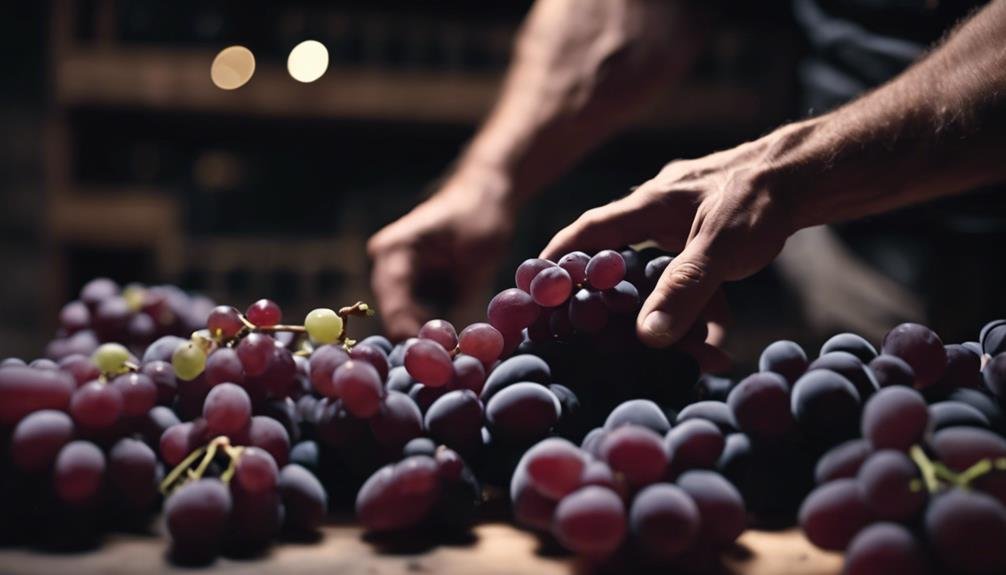Discover the impact of stem inclusion in winemaking: it enhances wine quality and complexity through whole cluster fermentation. Balancing tannin levels and acidity, it imparts unique flavors like spicy, herbal notes. Stem inclusion reduces acidity, boosts tannins, and adds complexity, particularly in Pinot Noir, Syrah, and Gamay wines. Stem-derived flavors offer herbal, grassy, and woody notes, elevating the wine experience. Stem lignification affects taste, quality, and vine maturity, guiding winemaking decisions. Cellaring whole cluster wines enhances aging potential, flavor evolution, and complexity, requiring specific storage approaches for ultimate maturation and character development. Explore how stem inclusion transforms wine profiles.
Stem Inclusion Benefits and Effects
Exploring the advantages and impacts of including grape stems in winemaking processes reveals a pivotal approach to enhancing wine quality and complexity. Stem inclusion techniques, commonly employed in winemaking, involve using whole cluster fermentation methods.
Stem fermentation experiments have shown that incorporating grape stems can result in wines with increased complexity, structure, and unique flavors. When utilizing stem inclusion techniques, winemakers aim to balance the tannin levels and acidity of the wine while adding spicy, herbal notes.
Stem Influence on Wine Quality
The impact of grape stems on wine quality encompasses a vital influence that extends beyond mere flavor enhancement in winemaking practices. Stems play an essential role in acidity reduction, contributing to a smoother taste by binding with tartaric acid and increasing pH levels.
Additionally, they greatly enhance the wine's tannin levels, providing structure and potentially improving aging potential. Stems can add complexity to the wine's flavor profile, demanding a powerful fruit presence to balance out any green notes they may introduce.
This balance between acidity reduction, tannin enhancement, and flavor complexity showcases the importance of stem inclusion in winemaking, especially in whole cluster fermentation techniques commonly used with grape varieties like Pinot Noir, Syrah, and Gamay.
Stem-Derived Flavors and Aromas

Stem-derived flavors and aromas in winemaking contribute a diverse range of herbal and botanical characteristics to the final product. Herbal nuances and botanical aromatics are prevalent when stems are included during fermentation.
Fresh green notes evoke living plants and chlorophyll, while dried green notes resemble roasted herbs. Green-brown notes offer spicy, woody, and earthy flavors, enhancing the complexity of the wine.
Stem fermentation plays a vital role in imparting these unique characteristics, adding layers of green, grassy, and woody flavors to the overall profile. The inclusion of stems introduces a variety of intriguing tastes that can enhance the sensory experience of the wine, providing a distinct and nuanced palate for wine enthusiasts to explore.
Grape Stem Lignification Impact
The lignification process of grape stems plays a significant role in influencing the overall taste and quality of wines, impacting the sensory experience for consumers. Stem lignification, the browning and hardening of grape stems, is an important factor in winemaking practices. Winemakers debate the optimal level of stem lignification for fermentation, as it signals grape ripeness and vine maturity.
The degree of lignification directly influences the chemical and flavor profile of the wine, affecting its complexity and structure. Understanding the impact of stem lignification on wine allows producers to make informed decisions about stem inclusion during the winemaking process. By evaluating stem hardness and color, winemakers can optimize the quality and characteristics of the final product.
Cellaring Whole Cluster Wines

Exploring the Influence of Whole Cluster Fermentation on Wine Aging Characteristics
- Aging Potential: Whole cluster wines exhibit enhanced aging potential due to the structural elements provided by the stems, contributing to the wine's ability to evolve and mature over time.
- Flavor Evolution: Cellaring whole cluster wines allows for the gradual development of flavors, with the presence of stems influencing the flavor profile as it evolves, showcasing the wine's complexity.
- Cellaring Strategies: Proper cellaring strategies for whole cluster wines involve providing ideal conditions to facilitate maturation effects, allowing for the harmonious integration of flavors and the refinement of the wine's overall character.
Frequently Asked Questions
How Do Winemakers Determine the Optimal Stem Quality for Whole Cluster Fermentation?
Winemakers assess stem quality for whole cluster fermentation by considering lignification level, color, and hardness. These factors influence acidity reduction, tannin enhancement, and flavor profile. Stem selection impacts fermentation outcomes, adding structure, complexity, and balancing acidity.
Can the Inclusion of Grape Stems in Winemaking Affect the Wines Aging Potential?
The inclusion of grape stems in winemaking can profoundly impact a wine's aging potential. Stem structure and fermentation impact contribute to the wine's complexity, structure, and ability to mature gracefully, enhancing its overall quality and development over time.
What Are the Key Differences in Flavor Profiles Between Green and Lignified Grape Stems?
The flavor profiles of green and lignified grape stems vary greatly. Green stems offer fresh, chlorophyll-like notes, while lignified stems provide spicy, woody flavors. Stem quality impacts mouthfeel, with green stems requiring powerful fruit balance and lignified stems influencing wine taste complexity.
Do Certain Grape Varieties Benefit More From Stem Inclusion in the Winemaking Process?
Certain grape varieties benefit more from stem inclusion in winemaking due to the varied influences stems bring. Stem fermentation enhances flavor development, adding complexity and structure. Pinot Noir, Syrah, and Gamay are among the varietals that showcase the significant impact of stems.
How Does the Lignification of Grape Stems Impact the Overall Mouthfeel of the Wine?
The lignification of grape stems impacts the overall mouthfeel of wine by influencing tannin levels and texture perception. Stem maturity affects the wine's structure, contributing to a smoother, more integrated mouthfeel, especially regarding tannin presence and complexity.
Conclusion
In the intricate tapestry of winemaking, the art of stem inclusion weaves a rich and complex flavor profile that captivates the senses. Like a symphony of notes harmonizing in a glass, the influence of stems adds depth and character to the final product.
As we savor each sip, we are transported to the vineyard, where the essence of the grape stems lingers, a reminder of the craftsmanship and passion that goes into creating each bottle of wine.